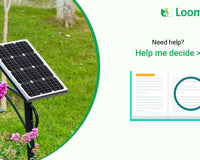Flour mills have traditionally relied on electric motors to power the machinery. The process of milling grain into flour requires a lot of energy, and electric motors were presumes to be most efficient and convenient way to provide that energy.
However today it is possible to use alternative energy sources, such as solar panels, to power a flour mill. Solar panels convert the energy from the sun into electricity, which can be stored in batteries for later use. This energy can then be used to power the electric motors that drive the machinery in the flour mill.
Solar panels are an ideal solution for powering flour mills in rural areas where access to the grid is limited or non-existent. The panels can be installed on the roof of the mill or in a nearby location, and the batteries can be used to store the electricity generated. This allows the mill to run 24/7, even when the sun is not shining.
To use solar panels for a flour mill, it is necessary to have a deep understanding of the energy requirements of the mill and the solar panel technology. The size of the solar panels and the number of batteries required will depend on the energy needs of the mill. It may also be necessary to invest in an inverter to convert the DC power generated by the solar panels into AC power that can be used to power the motors.
Flour mills can definitely run without electricity, it is possible to use solar panels as an alternative energy source. This solution is ideal for rural areas where access to the grid is limited, and it provides a reliable, clean and renewable energy source. With the right technology and planning, it is possible to run a flour mill using solar panels and reduce the dependence on fossil fuels.











